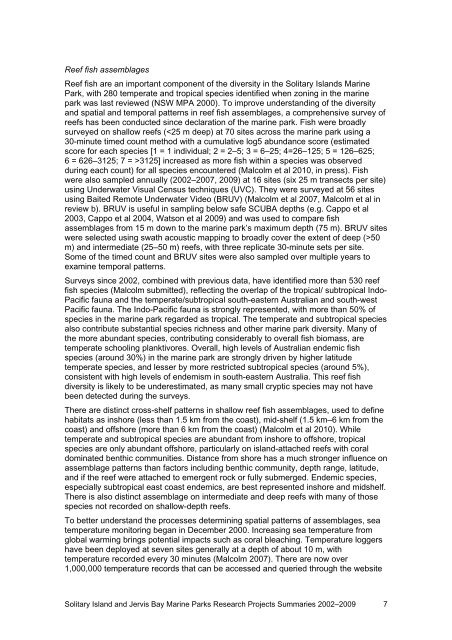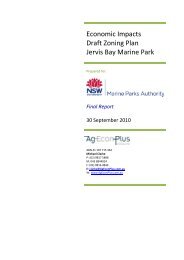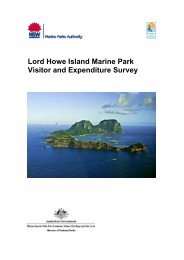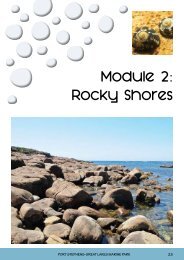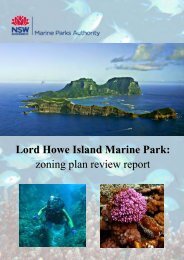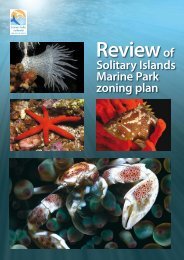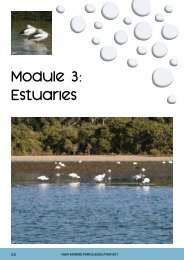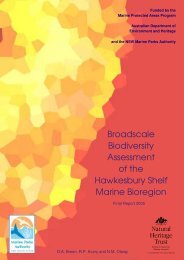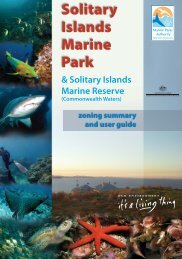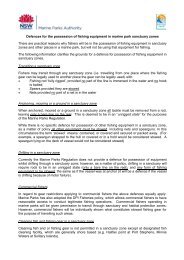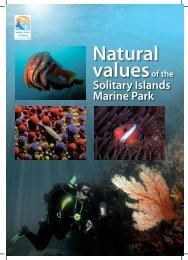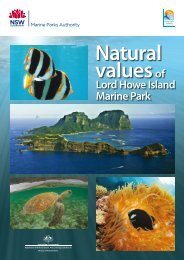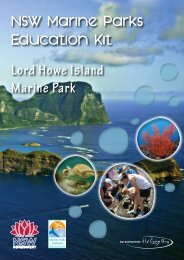Research Project Summaries 2002-2009 - Marine Parks Authority ...
Research Project Summaries 2002-2009 - Marine Parks Authority ...
Research Project Summaries 2002-2009 - Marine Parks Authority ...
Create successful ePaper yourself
Turn your PDF publications into a flip-book with our unique Google optimized e-Paper software.
Reef fish assemblagesReef fish are an important component of the diversity in the Solitary Islands <strong>Marine</strong>Park, with 280 temperate and tropical species identified when zoning in the marinepark was last reviewed (NSW MPA 2000). To improve understanding of the diversityand spatial and temporal patterns in reef fish assemblages, a comprehensive survey ofreefs has been conducted since declaration of the marine park. Fish were broadlysurveyed on shallow reefs (3125] increased as more fish within a species was observedduring each count) for all species encountered (Malcolm et al 2010, in press). Fishwere also sampled annually (<strong>2002</strong>–2007, <strong>2009</strong>) at 16 sites (six 25 m transects per site)using Underwater Visual Census techniques (UVC). They were surveyed at 56 sitesusing Baited Remote Underwater Video (BRUV) (Malcolm et al 2007, Malcolm et al inreview b). BRUV is useful in sampling below safe SCUBA depths (e.g. Cappo et al2003, Cappo et al 2004, Watson et al <strong>2009</strong>) and was used to compare fishassemblages from 15 m down to the marine park’s maximum depth (75 m). BRUV siteswere selected using swath acoustic mapping to broadly cover the extent of deep (>50m) and intermediate (25–50 m) reefs, with three replicate 30-minute sets per site.Some of the timed count and BRUV sites were also sampled over multiple years toexamine temporal patterns.Surveys since <strong>2002</strong>, combined with previous data, have identified more than 530 reeffish species (Malcolm submitted), reflecting the overlap of the tropical/ subtropical Indo-Pacific fauna and the temperate/subtropical south-eastern Australian and south-westPacific fauna. The Indo-Pacific fauna is strongly represented, with more than 50% ofspecies in the marine park regarded as tropical. The temperate and subtropical speciesalso contribute substantial species richness and other marine park diversity. Many ofthe more abundant species, contributing considerably to overall fish biomass, aretemperate schooling planktivores. Overall, high levels of Australian endemic fishspecies (around 30%) in the marine park are strongly driven by higher latitudetemperate species, and lesser by more restricted subtropical species (around 5%),consistent with high levels of endemism in south-eastern Australia. This reef fishdiversity is likely to be underestimated, as many small cryptic species may not havebeen detected during the surveys.There are distinct cross-shelf patterns in shallow reef fish assemblages, used to definehabitats as inshore (less than 1.5 km from the coast), mid-shelf (1.5 km–6 km from thecoast) and offshore (more than 6 km from the coast) (Malcolm et al 2010). Whiletemperate and subtropical species are abundant from inshore to offshore, tropicalspecies are only abundant offshore, particularly on island-attached reefs with coraldominated benthic communities. Distance from shore has a much stronger influence onassemblage patterns than factors including benthic community, depth range, latitude,and if the reef were attached to emergent rock or fully submerged. Endemic species,especially subtropical east coast endemics, are best represented inshore and midshelf.There is also distinct assemblage on intermediate and deep reefs with many of thosespecies not recorded on shallow-depth reefs.To better understand the processes determining spatial patterns of assemblages, seatemperature monitoring began in December 2000. Increasing sea temperature fromglobal warming brings potential impacts such as coral bleaching. Temperature loggershave been deployed at seven sites generally at a depth of about 10 m, withtemperature recorded every 30 minutes (Malcolm 2007). There are now over1,000,000 temperature records that can be accessed and queried through the websiteSolitary Island and Jervis Bay <strong>Marine</strong> <strong>Parks</strong> <strong>Research</strong> <strong>Project</strong>s <strong>Summaries</strong> <strong>2002</strong>–<strong>2009</strong> 7


